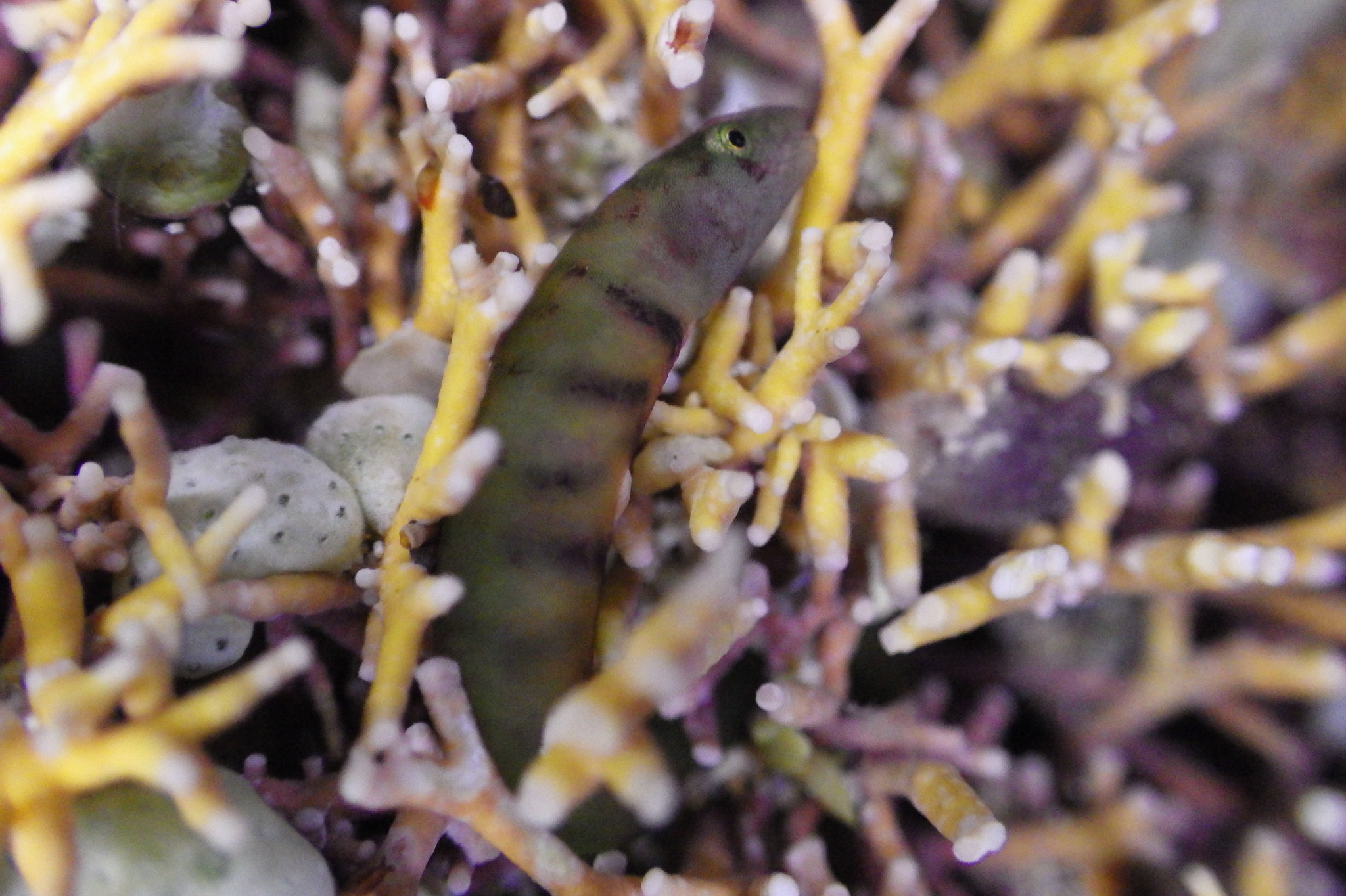Springer's Shore Eel, Alabes springeri Hutchins 2006

Springer's Shore Eel, Alabes springeri, at night in a rockpool in Cemetery Bay, Norfolk Island, Tasman Sea, October 2017. Source: msott / iNaturalist.org. License: CC BY Attribution-Noncommercial
Springer's Shore Eel, Alabes springeri Hutchins 2006
More Info
|
Distribution |
Known only from the Australian Territory of Norfolk Island in the Tasman Sea. The holotype was collected in Emily Bay, in a depth of one metre, and an individual was photographed at night in a rockpool in Cemetery Bay, Kingston. |
|
Features |
Cephalic pores 2; Postocular pores 1; Posterior nasal pores 0; Anterior nasal pores 1; Dorsal lacrymal pores 0; Ventral lacrymal pores 0; Vertebrae 71. Unique in lacking a pelvic fin rudiment, and in having a very small gill opening (8.8 in HL), a narrow interorbital space (8.8 in HL), only two cephalic pores in the lateral line system and an extremely short dorsal fin-fold beginning far back on the body well behind a positon above the urogenital papilla. Body elongate, subcylindrical, reaching a maximum depth at level of about anterior 3rd of body, then tapering posteriorly; body depth 11.1 in SL, maximum body width (= width at level of gill slit) 15.5 in SL; caudal peduncle absent (caudal fin joined to dorsal and ventral-fin folds); head small, length 7.0 in SL, a little wider than deep (head width 1.9 in HL); snout short, rather rounded to slightly truncate anteriorly in dorsal view, length 3.1 in HL; nostrils small but obvious, anterior one tubular, posterior one with low raised rim; eye moderate in size, with prominent clear cornea, diameter of orbit 3.7 in HL, noticeably greater than bony interorbital width (8.8 in HL). Gill opening a narrow slit, located on ventral surface of head, width 8.8 in HL; gills and branchiostegals not examined; mouth subterminal, upper jaw projecting over lower jaw, upper and lower lips rather narrow, rear corner of mouth not reaching anterior margin of eye (pigmented area); teeth incisorform, 1 row in upper and lower jaws; palatine and vomerine teeth absent. Skin smooth and scaleless, normally covered with a thick mucus layer; lateral line sensory system consists of minute papillae (latter very difficult to detect); cephalic pores 2 on each side of head, 1 postocular pore (POP) and 1 anterior nasal canal pore (ANP). Dorsal and anal-fin folds resemble low fins, but lacking both fin rays and underlying pterygiophores, continuous with caudal fin; caudal fin without visible fin rays, although there is evidence that the posterior portion of the specimen was damaged at some time (portion of caudal and anal-fin folds lost, and some vertebral elements also protruding through side of body); bases of dorsal and anal-fin folds relatively short, insertion of dorsal-fin fold well behind vertical through urogenital opening (snout to insertion 1.8, snout to urogenital opening 2.6, both in SL), snout to insertion of anal-fin fold 1.4 in SL; urogenital opening with small papilla. Total vertebrae 71, with last epipleural on 20th vertebra. |
|
Size |
31 mm SL. |
|
Colour |
In preservative, overall pale brown, fins more translucent, with slender triangular bands on the abdomen. Colour in alcohol. Head and body overall pale brown, fins more translucent. Springer and Fraser, 1976 illustrated some |
|
Biology |
Little is known of the biology of shore eels. |
|
Similar Species |
Differs from Alabes parvula in having an extremely short-based dorsal fin-fold, slender triangular bars on sides of abdomen and a bulbous throat. |
|
Etymology |
Named springeri in honour of Dr Vic Springer of the United States National Museum, who, along with Dr Tom Fraser in 1976, first reported the uniqueness of this specimen from Norfolk Island. |
|
Species Citation |
Alabes springeri Hutchins 2006, Mem. Mus.Vict. 63(1): 27, Fig. 2. Type locality: Port Hunter, 29°04'S, 167°57'E, Emily Bay, Norfolk Island, depth 1 m. |
|
Author |
Bray, D.J. 2019 |
|
Resources |
|
Springer's Shore Eel, Alabes springeri Hutchins 2006
References
Carpenter, K.E. & Smith-Vaniz, W.F. 2016. Alabes springeri (errata version published in 2017). The IUCN Red List of Threatened Species 2016: e.T67903591A115447452. http://dx.doi.org/10.2305/IUCN.UK.2016-3.RLTS.T67903591A67906390.en. Downloaded on 19 February 2019.
Hutchins, B. 2006. Description of two new species of shore-eels (Gobiesocidae: Cheilobranchinae: Alabes) from south-eastern Australia and Norfolk Island. Memoirs of Museum Victoria 63(1): 25-28 http://doi.org/10.24199/j.mmv.2006.63.5 Open access
Hutchins, B. & Morrison, S. 2004. Five new fish species of the genus Alabes (Gobiesocidae: Cheilobranchinae). Records of the Australian Museum 56: 147-158 DOI 10.3853/j.0067-1975.56.2004.1426 Open access
Springer, V.G. & Fraser, T.H. 1976. Synonymy of the fish families Cheilobranchidae (=Alabetidae) and Gobiesocidae, with descriptions of two new species of Alabes. Smithsonian Contributions to Zoology 234: 1-23 figs 1-14 https://doi.org/10.5479/si.00810282.234 Open access




